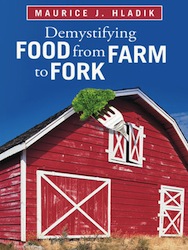This week I read, “Demystifying Food from Farm to Fork,” by Maurice J. Hladik. Many of you may be familiar with Hladik, an agricultural expert who has spoken at events all around the world including Commodity Classic. The goal of the book is to take a look at food production from “farm to fork”.
 As with many concepts, farm to fork can be defined in many ways. Hladik defines it as, “Pertaining to the human food chain from agricultural production to consumption. In other words, from our readers farm to my table.”
As with many concepts, farm to fork can be defined in many ways. Hladik defines it as, “Pertaining to the human food chain from agricultural production to consumption. In other words, from our readers farm to my table.”
As Hladik takes the reader through the varying stages in between the planting, growing and harvesting of food through manufacturing and eventually to the table, he explained the pros and cons, addressed any surrounding controversies and presented both sides of each argument. For this I was very impressed, as many writers take the view of “it’s my way or no way”.
Hladik also points out certain areas that he says are portrayed in the media as myths. One area he addressed was that of ethanol production and food prices. He writes, “There is a widespread conviction that the use of massive quantities of corn for the production of ethanol, and to a lesser extent soy beans for biodiesel, substantially contributes to hunger throughout the world….In reality, there is enough food in the world to go around, but getting it to all those who need it is a challenge.”
He continues by writing that the world does not need all the corn and other grains that are dedicated to biofuel production, and thus corn might as well be used for this purpose (he also rightly points out that a diet solely of corn does not constitute a balanced diet). In addition, he explains during his examination of “food versus fuel” that because of the increased need for corn for ethanol, along with the fact that growers are harvesting more bushels per acre than ever before, that should the unforeseen happen, the corn can be diverted to other areas – in essence, ethanol production is “money in the bank”.
This book is very well suited to those of us who are not very familiar with agriculture, and gives the reader a good, brief introduction into all the steps it takes to deliver our food to the table.

